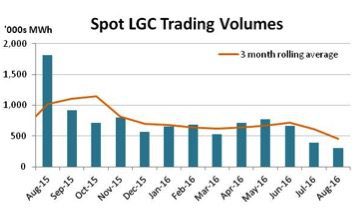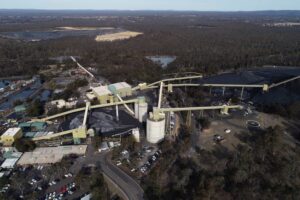
The nation’s large-scale renewable energy certificate market returned to a steady upward march across August, appreciating2.3% in a most consistent fashion. While overall trade volumes were again lower, the question now appears how soon prices will reach the market’s cap.
July had seen the LGC market’s climb disrupted with a mixed outcome prevailing. August on the other hand brought an unrelenting positive run, which saw the spot market close stable or higher on all but the final two days of the month. Having opened in the mid $85s the market stepped gradually up to the mid $86s by mid month, before ultimately reaching a high of $87.80 late in the piece. By month end the market closed back at $87.40.

While the pricing gains returned, trade volumes fell again in August with just over 300k reported during the month. Spot market activity levels were the lowest since late 2014.

With the market climbing once more some escalation returned to the forward curve for Cal 16 and Cal 17, with activity usually above the 2% mark more often than not. The Cal 18 market however remained in backwardation, sitting below the spot price across the month; a reflection of the fact that time brings uncertainty.
At a macro level, the issue impacting the LGC market continues to be the sense of inevitability that the market will ultimately be short. While the spot is still a small distance from fully pricing in such an outcome, if the market continues to rally much longer it soon will, leaving little reason for participants not to sell whatever stock they may have.
As it stands, the scheme still only appears likely to go into shortfall in calendar year 2018. The reductions in the surplus over the 2016 and 2017 compliance years however, will mean that only a very modest surplus is left over, which will more than likely be held by a range of participants for their own use in future years. This makes an effective shortfall in the 2017 compliance year likely.
Yet, with a spot price in the mid $87s, the market for Cal 17 now sits above $90, leaving less than $3 before the tax effective penalty level ($92.85) is reached. Hence, should the spot continue to rally in the short term, it would make little financial sense to hold onto any excess LGCs unless you were of the view that the market may rally beyond the tax effective penalty level.
Small-scale Technology Certificates (STCs)

The STC Clearing House remained in deficit across August with little activity taking place in the market.
Following a stronger start to August, STC submissions ultimately fell back below the level required to meet the 2016 target.
Marco Stella is Senior Broker, Environmental Markets at TFS Green Australia. The TFS Green Australia team provides project and transactional environmental market brokerage and data services across all domestic and international renewable energy, energy efficiency and carbon markets.







